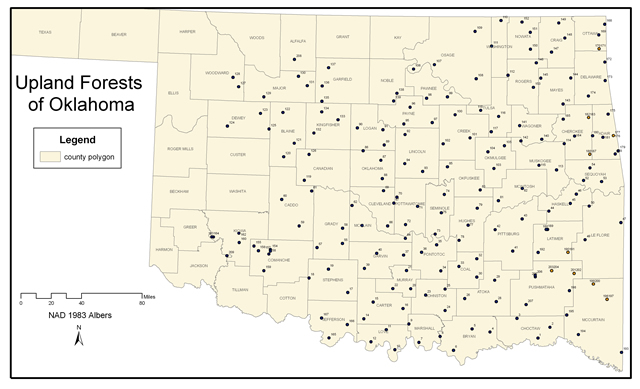In the summer of 1953, Elroy Rice and William T. Penfound embarked on a field project to quantify forest structure and composition. Over the next four years, they colleted forest vegetation data from 208 stands in 61 of Oklahoma's 77 counties. The analysis and results of this undertaking were published in 1959 as "Upland Forests of Oklahoma" in the journal Ecology.
The objectives of their research were stated as follows:
" A series of investigations on the deciduous forest frontier was inaugurated in 1953 at the University of Oklahoma. Initially it was planned to confine the studies to the blackjack-post oak forest, the major forest type of the forest-prairie ecotone. Subsequently it became necessary to include all of the upland forest types throughout the state. This report includes analytical data, obtained in the summer months from 1953 through 1957, from 208 upland forest stands. Objectives comprised the identification and distribution of all relatively undisturbed forest types and a quantitative description of each stand based on the woody species. No data were obtained on herbaceous plants because of the necessary variation in time of sampling and the unequal amount of grazing in the diverse stands. During the last two years of the investigation, data were secured on the death of trees caused by the extended drought (1952-1956)."
A footnote on the opening page of Rice and Penfound (1959) indicates that their work was "a contribution of the Oklahoma Biological Survey, Dr. Carl D. Riggs, director." Both Rice and Penfound were faculty in the Department of Botany at the University of Oklahoma; Rice joined the faculty in 1948 and retired in 1981, Penfound was on the faculty from 1947 to 1967. The Oklahoma Biological Survey (OBS) has archived mimeographed copies of summary data used by Rice and Penfound in compiling the upland forest paper. These data represent the forms referred to on page 598 of the paper: "after field notes were brought into the laboratory the following data on each species were entered on a prepared form..." The data contained on each form were used to prepare county and regional summaries, but individual site data were not presented in the 1959 paper. It must be emphasized that these are not raw field data, but site summaries that consist of three components; 1) site (description [including past land use history], location, size, and ownership, 2) qualitative species information, and 3) quantitative summaries for each species at each site. The whereabouts of the original field data are unknown.
The intent of this webpage is to provide these data in a searchable online database for researchers, educators, and the interested citizens interested in the past and future of Oklahoma forests.
Begin search